COMMUNICATION NETWORKS
Unit Overview
By the end of this unit the student will be able to define the term network, identify the three common types of networks, and list the different types of network configurations. The student will also describe the benefits of networking computers.
 |
What is a Communications Network?
A communications network is a group of computers and other devices that are connected through a communications line so they are able to transmit data and information. Most computers in offices, hospitals, and schools are networked together. Many use a server, a special computer that controls the sharing of information over a network.
The most simplistic design of a communications network contains a computer, a device that sends/receives data, a communications link, another device that receives/sends data, and another computer.
Types of Computer Networks
There are three common types of computer networks. They are the Local Area Network (LAN), the Metropolitan Area Network (MAN), and the Wide Area Network (WAN). These networks differ in the geographic area that they cover and the number of workstations that are connected through the network.
The Local Area Network is a small network that typically uses a file server to control the flow of information over the network and to store all of the software used by computers on the network. LAN’s are limited in the geographic area they cover ranging from the size of a classroom to as large as an entire building. Most LAN’s use cables to connect each workstation to the network.
The Metropolitan Area Network spans a much larger geographic area than a LAN. MAN's can be as large as an entire city or school district. MAN’s connect smaller networks together allowing data to be efficiently transmitted. Many library systems use a Metropolitan Area Network.
The Wide Area Network covers the largest geographic area, like an entire state or country. It connects LAN’s and MAN’s to global networks, such as the Internet.
Data Transmission Signals
There are two types of data transmission signals. They are analog and digital. Digital signals use electrical pulses to transmit data while analog signals are made up of a continuous electrical wave. Analog signals are used by phone lines and speakers while digital signals are used by computer equipment. To enable phone lines to carry digital signals a modem is used. Modem stands for modulate/demodulate and converts digital and analog signals.
Types of Line Connections
Point-to-point lines are direct lines that connect a sending device with a receiving device. There are two types of point-to-point lines: a switched line and a dedicated line.
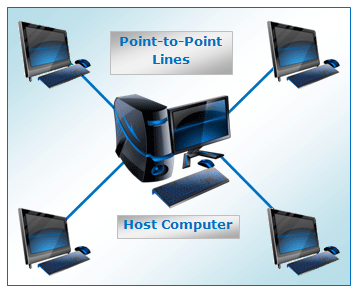 |
A switched line establishes a new connection each time you connect to the network. Using regular telephone lines, a switching station selects the line that will be used for your connection. The connection is established when the receiving equipment answers the call of the sending equipment. The connection is ended when either side of the equipment terminates the call.
A dedicated line provides a constant connection between a sending and receiving device. Dedicated lines provide a high quality connection that increases the reliability and stability of data transmission. Dedicated lines use cables to connect to devices or locations.
A multipoint line is a single line that connects multiple devices to a host computer. Multipoint lines are shared by several computers connecting to the same device or location.
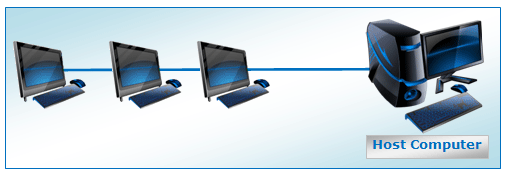 |
Types of Cable
There are three common types of cable used for connections in a network using cable. Each type of cable has its own bandwidth and speed which affects the transmission rate of data.
Twisted Pair cable consists of four pairs of wires contained inside an outside layer of insulation. Each pair has a unique number of twists per inch to reduce interference from nearby pairs and other electrical devices. There are two types of twisted pair: unshielded and shielded twisted pair. Shielded twisted pair contains additional shielding. Of the two, unshielded is used most often because it is less bulky. Twisted pair cable is divided into six categories. Category 1 is used for voice only telephone service, while Category 6 is used for gigabyte service. Category 5 is one of the most commonly used twisted pair cable for Ethernet network.
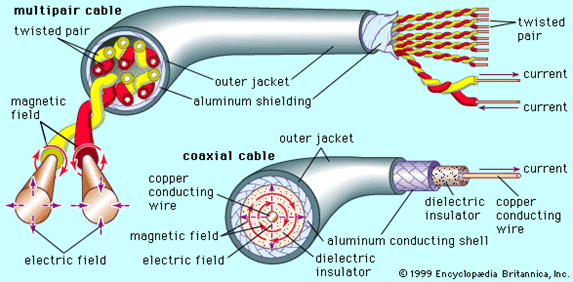
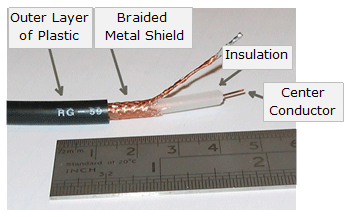
Coaxial cable is comprised of a center conductor made of copper, a layer of insulation, a braided metal shield, and an outer layer of plastic. There are two types of coaxial cable called thinnet and thicknet. Thicknet has an extra layer of plastic.
Fiber Optic cable is comprised of a center core made of glass or plastic fibers, a layer of plastic coating, a layer of fiber, and an outer layer of insulation. Fiber optic cable is growing in popularity because it can carry larger amounts of information and send signals over longer distances in less time than twisted pair or coaxial cable.
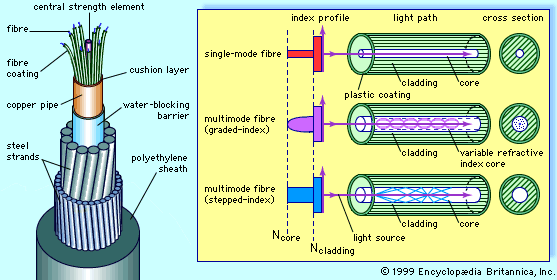
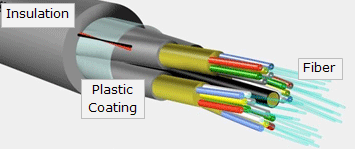
Not all networks use cable. Some wireless networks use radio signal, lasers, microwaves, and satellites to send and receive data over a network.
Types of Protocols
A protocol is a set of rules that controls the sending and receiving of data among computers on a network. The protocol decides what information is exchanged and in what order. Protocol regulates the network’s access method, the physical topologies, cabling, and data transfer speed
Some common protocols are: Ethernet, LocalTalk, FDDI, and ATM. In the table below an overview of each protocol has been provided.
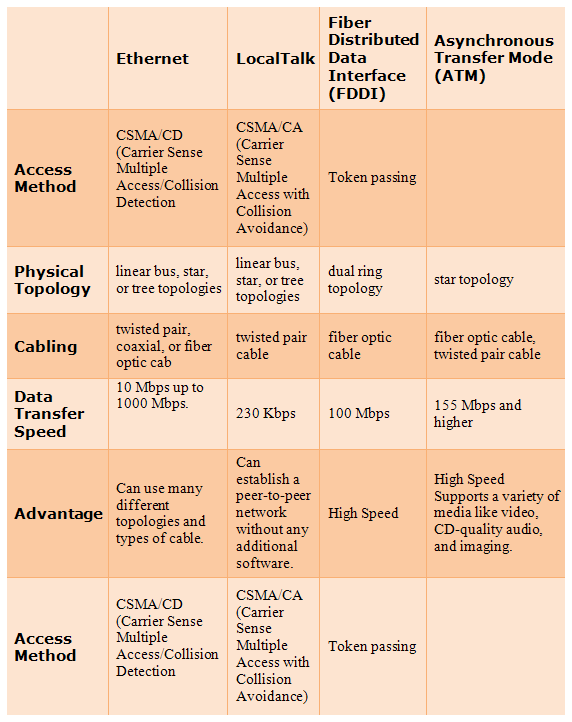
|
Telecommunications Network
Network switches, or nodes, enable users (stations) to link to any number of network users through communications channels.

|
Types of Physical Topology
Physical topology is the configuration of all of the network’s cables, computers, and other devices. The word “node” is used to describe any device that is on the network. The type of physical topology used is determined by the geographic area the network covers and the stability that is needed. Some of the most common physical topologies are: star, bus, and ring.
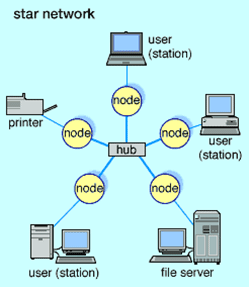 |
Using star physical topology, all nodes are connected to one host computer or a network hub. The host computer is responsible for storing all data and handling network tasks. This configuration allows data to be closely controlled and permits all users to have access to up-to-date data. One disadvantage of this configuration is that if the host computer crashes the entire network would go down. |
 |
Using bus physical topology, the same communications line is used to connect all nodes. This design allows all computers to send and receive data to each other in both directions on the line without using a server. If one node crashes, it does not impact the network’s ability to function. The bus network can only effectively be used for a limited number of computers. |
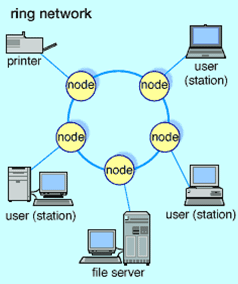 |
Using the ring physical topology, nodes are connected to each other in a circle. The ring pattern does not have a host computer for storing data. Data is transmitted around the ring in one direction. One disadvantage to this network design is that if one node crashes it knocks out the entire network. |
Connecting Networks
Networks can be connected to each other. A combination of software and hardware must be used to do the job.
A gateway connects networks of different kinds, for example, connecting a network of PCs to a main frame network. This can be complex! |

|
| A bridge connects networks of the same type. This job is simple. | 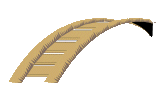
|
A router connects several networks. A router is smart enough to choose the correct path for communications traffic. If there is a partial failure of the network, a router seeks an alternate route. |
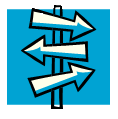
|
Why Network?
One reason for networking computers is to enable them to share resources. When computers are networked, they can share expensive equipment, such as laser printers. Another advantage of networking is the ability to access information stored on other computers on the network. This has been shown to increase employee productivity. In addition, many common applications such as e-mail, the Internet, facsimile, and voice mail rely on the infrastructure of a communication network. Finally, networking enables computers to use software programs that have been installed in another location on the network. This conserves the individual computer’s resources and reduces software installation and setup time.